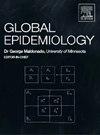Trends, prevalence, and determinants of unfavorable tuberculosis treatment outcomes among adult patients in Northeast Ethiopia: The race to achieve a 90 % treatment success rate by 2025
引用次数: 0
Abstract
Background
Tuberculosis (TB) continues to be a significant public health issue, especially in developing nations like Ethiopia. The country aims to reach a 90 % treatment success rate for TB by 2025. However, there is a considerable lack of recent data on treatment outcomes in the region. Current data on treatment outcomes and their determinants are crucial for guiding early interventions and aligning efforts with national goals and the End TB Strategy. Understanding the current state of TB treatment outcomes and influencing factors is vital for implementing effective interventions and measuring progress toward the target.
Methods
A four-year retrospective study (2019–2022) was conducted. From 323 patient files, 312 were eligible to be included in the final analysis, resulting in a response rate of 96.6 %. Data collection utilized a structured checklist, and analysis was performed with STATA version 18. The Mann-Kendall trend test was used to detect trends in TB incidence. Multicollinearity was checked using variance inflation factors (VIFs). A logistic regression model identified determinants of treatment outcomes.
Results
The study revealed that 84.94 % of participants achieved favorable treatment outcomes, while 15.06 % had unfavorable outcomes. A decreasing trend in unfavorable outcomes was noted, from 18.84 % in 2019 to 10.71 % in 2022 (Kendall's tau (τ) = −0.0686). Determinants of unfavorable outcomes included older age (AOR: 3.59, 95 % CI: 1.23–10.56), HIV positivity (AOR: 5.43, 95 % CI: 1.65–10.83), and smear-negative pulmonary TB (AOR: 3.82, 95 % CI: 1.39–10.45).
Conclusion
The overall treatment success rate of 84.94 % is below the global target of >90 % for 2025. Tailored treatment strategies for older patients and those co-infected with HIV are recommended. Additionally, improving TB diagnostic capabilities is essential for early intervention and achieving better outcomes.
埃塞俄比亚东北部成年患者结核病治疗结果不利的趋势、流行率和决定因素:到2025年实现90%治疗成功率的竞赛
结核病(TB)仍然是一个重大的公共卫生问题,特别是在埃塞俄比亚等发展中国家。该国的目标是到2025年达到90%的结核病治疗成功率。然而,关于该地区治疗结果的近期数据相当缺乏。目前关于治疗结果及其决定因素的数据对于指导早期干预和使努力与国家目标和终止结核病战略保持一致至关重要。了解结核病治疗结果的现状和影响因素对于实施有效干预措施和衡量实现这一目标的进展至关重要。方法采用4年回顾性研究(2019-2022年)。从323例患者档案中,312例符合纳入最终分析的条件,有效率为96.6%。数据收集使用结构化检查表,并使用STATA版本18进行分析。使用Mann-Kendall趋势检验来检测结核病发病率的趋势。使用方差膨胀因子(VIFs)检查多重共线性。逻辑回归模型确定了治疗结果的决定因素。结果84.94%的参与者获得了良好的治疗结果,15.06%的参与者获得了不良的治疗结果。不利结果呈下降趋势,从2019年的18.84%降至2022年的10.71% (Kendall τ (τ) = - 0.0686)。不良结局的决定因素包括年龄较大(AOR: 3.59, 95% CI: 1.23-10.56)、HIV阳性(AOR: 5.43, 95% CI: 1.65-10.83)和涂片阴性肺结核(AOR: 3.82, 95% CI: 1.39-10.45)。结论总治疗成功率为84.94%,低于2025年90%的全球目标。建议为老年患者和合并感染艾滋病毒的患者提供量身定制的治疗策略。此外,提高结核病诊断能力对于早期干预和取得更好的结果至关重要。
本文章由计算机程序翻译,如有差异,请以英文原文为准。
求助全文
约1分钟内获得全文
求助全文

 求助内容:
求助内容: 应助结果提醒方式:
应助结果提醒方式:


